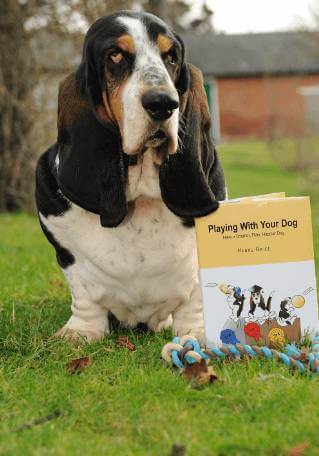
Ask most dog owners and they’ll agree that their pet is a highly valued member of the family. So, when the inevitable happens, the grieving process we go through is often similar to what we’d experience if a human family member or close friend had died. But what about those of us that have multi-pet households; does the passing of one animal affect another?
Do animals grieve?
There’s plenty of anecdotal evidence to suggest that animals experience grief. In July 2015, the emotions in many were stirred when video of an adult bottlenose dolphin was captured off the western coast of Italy, seemingly trying to revive the body of a dead dolphin calf. The calf’s mother repeatedly nudged the young dolphin’s inanimate body.
Similar behaviour was seen in 2013, when an adult dolphin was observed carrying the body of a dead calf out to sea. Dolphins are not the only animals that appear to mourn their loved ones. In Barbara J King’s book ‘How Animals Grieve’, she cites numerous cases of a wide range of species including cetaceans, great apes, elephants, farm animals and domestic pets that have acted in ways similar to humans when we grieve.
But the debate about whether animals, including man’s best friend, experiences emotions such as grief, depression and happiness has raged for years. In fact, just a couple of centuries ago, many scientists and philosophers believed dogs were simply dumb animals incapable of thought – let alone any levels of emotionality. French philosopher René Descartes suggested dogs had no intelligence, reasoning or consciousness, they were instead controlled by physical reflexes and unthinking responses to things that stimulate them. This thinking was challenged by Charles Darwin in 1859 with the publication of ‘The Origin of Species’. Darwin concluded animals and people just have differing levels of awareness, reasoning ability, intelligence and memory.
While some may argue that complex emotions such as love or grief is simply being anthropomorphic, brain-imaging techniques have shown that humans form emotions in the primitive parts of the brain, such as the limbic system, and that’s something we share with all mammals including Fido. The same neurotransmitter chemicals, such as dopamine and other endorphins, are also identical across different species. So, one has to ask – if humans share the same anatomy, physiology and biochemistry as our four-legged friends, why wouldn’t they experience similar feelings?
In 2012, scientists at the Cambridge Declaration on Consciousness in Non-Human Animals, agreed that animals experience moment-to-moment consciousness, just like humans, the key differences is that humans use their frontal cortex to plan, think and reflect. Marc Bekoff from University of Colorado is also in agreement, he says: “Many animals feel ‘love’ as well as ‘grief’, even these concepts are hard to define precisely.” Bekoff continues: “We humans do not fully understand love, but we do not deny its existence – or its power to shape our emotional responses.”
If evidence suggests that animals mourn – how does this explain why some animals appear to grieve while others don’t?
More research is needed to truly understand this, but I have a couple of thoughts under what I call “Hanne Science”;
1. If animals are capable of experiencing moments of consciousness like us, then maybe some pets are more obvious in showing their emotions than others because of differing empathy levels? Empathy is one of the factors that Dr Brian Hare and his team at Duke University look at to better understand dogs’ intelligence and character. Working through a set of games on the Dognition website, owners can submit their results to Dr Hare’s team and this generates a unique profile for your dog. Because the profile illustrates which factors are used predominately by your pet, owners can see what their dog’s memory is like, and even where Fido rates on the empathy level. So if a dog rates high of the empathy scale, could this be a contributing factor to any obvious behaviour change, such as lament, when his companion dies?
2. Or, could it be that because long-term animal companions can often become fond of each other (they may play, groom or choose to sleep together), if one dog is highly bonded to another perhaps that animal’s behaviour might be different to one that had no – or – little emotional attachment to the deceased? Here’s an assumption; if my dog Howard was to pass away, it is likely that Evie (one of my cats) would show little outward signs of stress as she currently ‘tolerates’ the dog – even after 8 years of living together! Yet when George (my eldest cat) died, my dog seemed ‘lost’ for several days and was very quiet. These two companions were highly bonded and chose to hang out together. Could this explain why some pets don’t appear to exhibit any signs of grief? As I said, this is ‘Hanne Science’ but read the case study of Lizzie Lewis below and see what you think.
Helping pets adjust
While we may not have all the answers yet and the debate about emotionality continues, what we can do is help the remaining pets in our household adjust when the inevitable happens. Here are some tips.
1. Using your dog’s senses to cope. If possible, allow your surviving pet access to see and smell the deceased animal. If this isn’t possible, then enable them to sniff, for example, the collar your pet was wearing or the blanket it was laying on. This may help your dog understand what has happened.
2. Stick to your ‘normal’ routine. The loss of a four-legged friend is a huge change for the surviving pet, so it is important to keep to your typical routine as much as possible, such as feeding and walking times.
3. Keep your pet’s mind and body active. Exploring new environments while out on a walk and playing with your dog will not only promote the secretion of ‘happy hormones’ but it will also help blow the cobwebs away for you too. See Playing With Your Dog for enrichment ideas.
4. Avoid unwittingly reinforcing any unwanted behaviour. Some dogs may, for example, become more vocal and whine, stop eating or follow you around the house. Avoid making a big fuss about this; instead focus on reinforcing good behaviour. You can redirect your dog’s attention by keeping Fido busy with food puzzle toys, hide and seek games and so on.
5. Highly social dogs may enjoy having a new walking/play companion. If your dog is very sociable and seemingly enjoys the company of others, then consider arranging playdates with a well-balanced dog friend. This companion can offer support and welcome distraction. Some owners may even consider getting a new companion. However, take a common sense approach with this: consider your home situation – ask yourself how much time you have to invest in training a new pet and the additional costs; consider the personalities of your surviving pet[s] so you can make an informed decision on the ‘best-match’ for your household; and ensure introductions plus interactions are well-managed. After all, there is no such thing as an ‘instant friend’.
6. Professional support. If your pet is struggling and you are noticing changes in their behaviour, speak with your vet in the first instance to discuss options for complementary support, such as nutraceuticals, or whether behavioural medicine is needed to help your pet adjust to the sudden change. In addition, working with a certified behaviour therapist can be hugely beneficial in getting appropiate advice, as well as creating a bespoke plan to support you and your animal. Check out the practitioner directory via the Animal Behaviour and Training Council.
Case study: Lizzie Lewis – Spike & Ted
 “Ted, our ex Battersea rescue Labrador, was a great dog but could be a little anxious. So, five years ago we got a puppy called Spike, a Terrier cross, to keep Ted company. Very quickly the two become great friends; Spike did Ted the world of good. Even though Ted was a big Lab, he’d sleep with Spike in his puppy crate until Spike grew, then the pair would sleep in Ted’s bed. Spike learnt all his doggie manners from Ted and in every way they were a team. In February this year Ted became very ill, it looked like he would have to be put to sleep and we were very concerned about Spike’s reaction. We consulted our vet, he advised to keep Spike at home when we took Ted to the surgery to say our final goodbye. When we came home, Spike was immediately looking for Ted but soon enough settled down. However, that evening when we went to bed Spike howled, barked and cried. We just couldn’t settle him. Eventually, Spike came into our bedroom where he continued to be restless. The next evening was the same, despite putting our worn fleeces in his bed for him to snuggle up to. In the end, we brought out Spike’s old puppy crate and that seemed to help. Over the following days and weeks, we noticed Spike was becoming very attached to me. He wouldn’t leave my side and started to become anxious. So, about two months after Ted passed, we decided to get another pet and took in an elderly female rescue dog. While she’s helped Spike a lot and his anxiety has lessened, the bond just isn’t the same as it was with friend Ted.”
“Ted, our ex Battersea rescue Labrador, was a great dog but could be a little anxious. So, five years ago we got a puppy called Spike, a Terrier cross, to keep Ted company. Very quickly the two become great friends; Spike did Ted the world of good. Even though Ted was a big Lab, he’d sleep with Spike in his puppy crate until Spike grew, then the pair would sleep in Ted’s bed. Spike learnt all his doggie manners from Ted and in every way they were a team. In February this year Ted became very ill, it looked like he would have to be put to sleep and we were very concerned about Spike’s reaction. We consulted our vet, he advised to keep Spike at home when we took Ted to the surgery to say our final goodbye. When we came home, Spike was immediately looking for Ted but soon enough settled down. However, that evening when we went to bed Spike howled, barked and cried. We just couldn’t settle him. Eventually, Spike came into our bedroom where he continued to be restless. The next evening was the same, despite putting our worn fleeces in his bed for him to snuggle up to. In the end, we brought out Spike’s old puppy crate and that seemed to help. Over the following days and weeks, we noticed Spike was becoming very attached to me. He wouldn’t leave my side and started to become anxious. So, about two months after Ted passed, we decided to get another pet and took in an elderly female rescue dog. While she’s helped Spike a lot and his anxiety has lessened, the bond just isn’t the same as it was with friend Ted.”
References:
– Bekoff, M., (2000) Animal Emotions: Exploring Passionate Natures. BioScience, Volume 50, Issue 10, pages 861-869.
– King, B.J., (July 2013) When Animals Mourn. Scientific American, page 63.
– Overall, K. L. (2013). Manual of Clinical Behavioral Medicine for Dogs and Cats. Elsevier Health Sciences.
Learn more about our classes

Get Hanne's book, clothing and more
Hanne has a number of publications including her book Playing With Your Dog to help owners work out the games that are best suited for their pet to play throughout his life, from puppyhood to old age, available from Amazon. Check out Hanne's range of contemporary casuals The Collection – for pet lovers made from recyclable, organic materials that are sustainably sourced.

